

Missfelicity. Afghan cameleers: Australia's outback history. IN THE SHIMMERING HAZE, turbans, sandalled feet and dark beards mingled with the plain dungarees of the bushmen as a crowd rushed to collect mail from the train that had just pulled in.
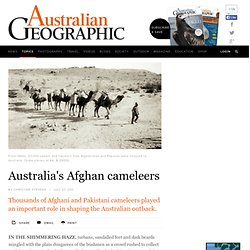
Suddenly the hiss of steam and the excited babble were punctuated by the sound of gunshots. An Afghan fell to the ground, wounded. Another swiftly and silently slipped away into the surrounding desert. The place was Marree, South Australia; the year was 1904. Early one hot December morning in 1986, I recalled that story as I sat under sparse shade in a dry, red-soil creek bed at Farina, 50 kilometres from Marree. As we sat in the creek bed, sipping from Charlie's cool water-bag I tried to picture the nearby barren hillock as it had been in 1904 when occupied by tin huts, camel-yards, a simple mosque and an entire Afghan community.
Only a few weeks before, the young cameleer had been betrothed to a girl of 14 from the Marree Ghantown. Birdsville cameleer Ghantowns - apart of Australia's foundation years. Camels Australia Export - Central Australia - Northern Territory - Australia. Migration. Australia’s migration history. Australia’s migration history The nineteenth century In 1788, when European settlement began, Australia’s Aboriginal population was about 400,000.
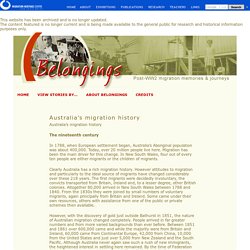
Today, over 20 million people live here. Migration has been the main driver for this change. In New South Wales, four out of every ten people are either migrants or the children of migrants. Afghan cameleers in Australia. By the mid-1800s, exploration in Australia was at its peak with expeditions setting out almost monthly.
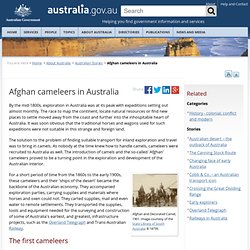
The race to map the continent, locate natural resources or find new places to settle moved away from the coast and further into the inhospitable heart of Australia. It was soon obvious that the traditional horses and wagons used for such expeditions were not suitable in this strange and foreign land. The solution to the problem of finding suitable transport for inland exploration and travel was to bring in camels.
As nobody at the time knew how to handle camels, cameleers were recruited to Australia as well. Australian Immigration Fact Sheet 4. More than 60 Years of Post-war Migration. On this page The Department of Immigration and Border Protection has facilitated the permanent migration of more than seven million people since its establishment in 1945.
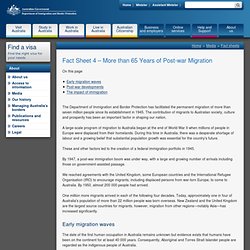
The contribution of migrants to Australian society, culture and prosperity has been an important factor in shaping our nation. A large-scale program of migration to Australia began at the end of World War II when millions of people in Europe were displaced from their homelands. During this time in Australia, there was a desperate shortage of labour and a growing belief that substantial population growth was essential for the country's future. These and other factors led to the creation of a federal immigration portfolio in 1945. By 1947, a post-war immigration boom was under way, with a large and growing number of arrivals including those on government-assisted passage. Www.immi.gov.au/media/publications/statistics/federation/timeline1.pdf.
Australia's Muslim Cameleers. Afghan cameleers in Australia. Cameleers-teacher-notes. Photograph - Camel Cart, Egypt, 1928 - Museum Victoria. Australia's migration history timeline. Objects through Time traces the history of migration of people, technology and ideas to our shores through a collection significant objects, spanning a 60,000 year time frame.
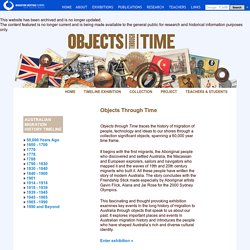
It begins with the first migrants, the Aboriginal people who discovered and settled Australia, the Macassan and European explorers, sailors and navigators who mapped it and the waves of 19th and 20th century migrants who built it. All these people have written the story of modern Australia. The story concludes with the Friendship Stick made especially by Aboriginal artists Gavin Flick, Alana and Jai Rose for the 2000 Sydney Olympics. This fascinating and thought provoking exhibition examines key events in the long history of migration to Australia through objects that speak to us about our past.
It explores important places and events in Australian migration history and introduces the people who have shaped Australia’s rich and diverse cultural identity. Enter exhibition » Rory2007. Rory2007. A Brief History of Camels in Australia. Camelids are believed to have originated in North America.
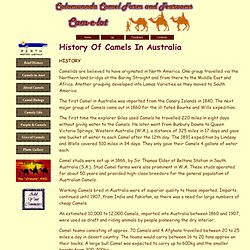
One group travelled via the Northern land bridge at the Baring Straight and from there to the Middle East and Africa. Another grouping developed into Lamas Varieties as they moved to South America. The first Camel in Australia was imported from the Canary Islands in 1840. The next major group of Camels came out in 1860 for the ill-fated Bourke and Wills expedition. The first time the explorer Giles used Camels he travelled 220 miles in eight days without giving water to the Camels. Camel studs were set up in 1866, by Sir Thomas Elder at Beltana Station in South Australia (S.A.). Working Camels bred in Australia were of superior quality to those imported. An estimated 10,000 to 12,000 Camels, imported into Australia between 1860 and 1907, were used as draft and riding animals by people pioneering the dry interior. Camel teams consisting of approx. 70 Camels and 4 Afghans travelled between 20 to 25 miles a day in desert country.